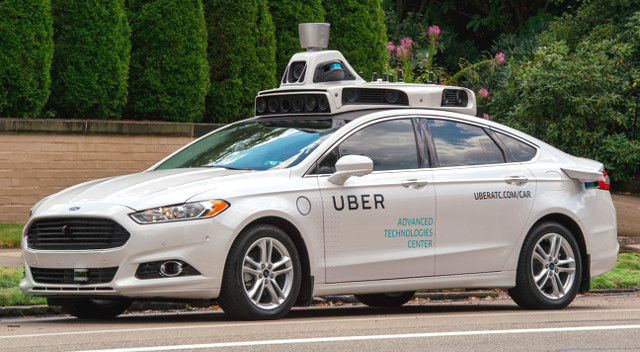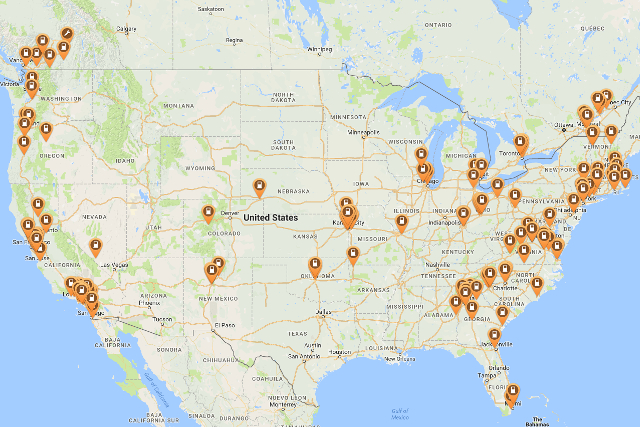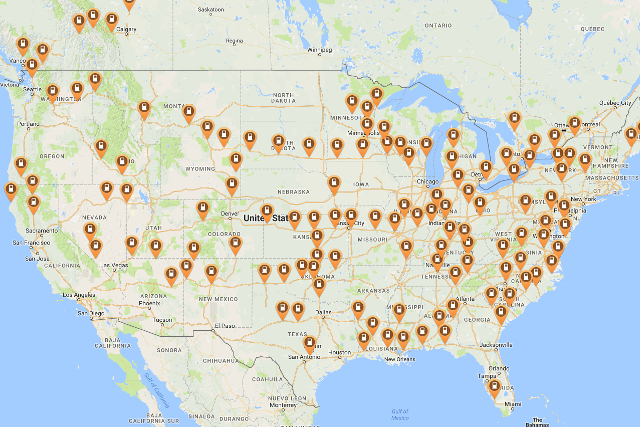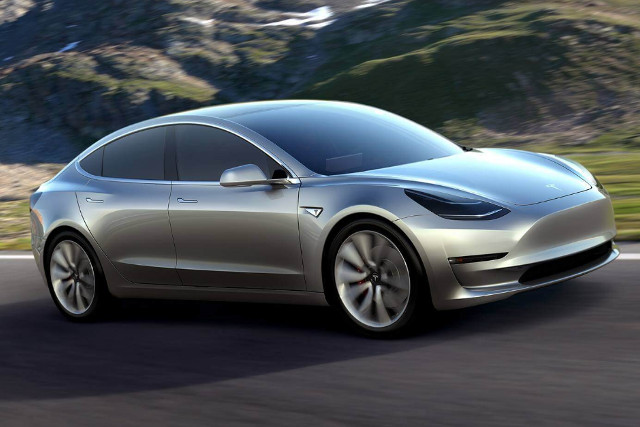Tesla’s Model 3 | Image: Tesla
Meet the Bolt
Not to be confused with the Chevy Volt, the Chevy Bolt (really guys? you need to work on your branding) will be a fully-electric vehicle with a 238-mile range and a $37,500 price tag. It sounds pretty good, especially since it’s going to be out in jut a few months, while those who’ve pre-ordered a Tesla Model 3 — which right now boast a $35,000 price tag and 218-mile range, though as we’ve seen that could well change — will have to wait until some time next year for delivery. But I’d still take the Tesla, at least for now, and these two maps from Plugshare show why:
On top, the network of CCS fast charging stations using the standard GM is using. On the bottom, the Tesla Supercharger network. I can’t tell you which is faster for certain — GM says theirs can give you 90 miles of range in about 30 minutes, and reports from Tesla owners vary from only 42 miles to a whopping 125 miles in the same amount of time — but I can tell you that an extra 20 miles in a full charge isn’t going to make a lick of difference. GM itself estimates that the average daily commute is 40 miles, so whether you’re getting 238 or 218 miles, you’re still only getting to work and back five times. Meanwhile with supercharging stations uniformly spread across the US, the Tesla users will be able to cross the country. GM, on the other hand, “are not actively working on providing infrastructure [for the Bolt EV],” instead relying on other, more desperate manufacturers to build them for them. We’ll see how that goes. On top of that, the Tesla is cheaper, and looks better.
Seriously, why does it have to look so bad? So roll on competition for the Tesla, but don’t expect Elon to be quaking in his boots, either.
Uber’s Self-Driving Cars Hit Pittsburgh

This week Uber announced that its first generation of self-driving test-cars have hit the streets in Pittsburgh. Counter to my expectations (I had been expecting Volvo XC-90s, which aren’t joining in until later), the project consists of a small fleet of Ford Fusions equipped with all manner of sensors and cameras mounted on top. They still require a driver — one reporter noted that his car “dropped out” of self-driving mode a number of times on his trip alone — but the purpose of the rollout isn’t to demonstrate a final product, but rather to gather data to make the cars one day entirely driver-free. There’s a detailed (and entertaining) video of one journalist’s experience in the car that’s really worth checking out at the Verge. And I, for one, welcome our robot-driver overlords.
Monsanto No More
This week the massive chemical and pharmaceutical company Bayer signed an agreement to purchase the company with the most hated name in agribusiness, Monsanto, for $66 billion US in cash. While I don’t hate Monsanto very much at all — I find most of the Monsanto haters to be anti-GMO activists without much of a leg to stand on — I do worry that such a large merger will create problems for the agricultural chemicals market and make life even harder for farmers. This also comes at a time of increasing consolidation in the market: PotashCorp and Agrium will be the world’s largest fertilizer corporation if the merger goes through, the merger of giants Dow Chemical and DuPont is still waiting on regulatory approval, and the ChemChina acquisition of Syngenta has just passed US regulatory approval. It’s by no means certain that the deal will go through, but if it does, “March Against Monsanto” might need to find a new name. Vox has more on the story.
ICYMI
Because you’re busy people, you might’ve missed one of our posts this week. Don’t worry, here they are again:
- On Monday, I talked about the (not really) suspicious “lack of forests” on the “flat Earth”
- On Tuesday, I wrote about Jeff Bezos’s plans to give Elon Musk real competition
- On Wednesday, I suggested alternate employment for now ex-Bake Off host Sue Perkins
- On Thursday, I did something really lazy and posted something that happened in 2008, and
- On Friday, Elle reminded us that we’re better than insulting the appearance of women, even (or especially) the ones we don’t like
If you missed any of them, here’s your chance!
Best of the Rest
And because there are only so many hours in the day, here’s some of the things we missed this week, in handy point form. Enjoy!
- We have answers to the Presidential Science Debate questions!
- iOS 10 has some problems with porn in its search results
- Cassini has one year left in its mission to Saturn
- Scientists have created a spectacular reconstruction of a dinosaur (and it’s adorable)
- Someone made a billion-star 3D map of the cosmos
- Some folks in Argentina just dug up a 30-ton meteorite, and
- Scientists have realized that adding in two new letters to the normal four (A, C, T, and G) has made light toxic to a new strain of e. coli
***
That’s all for today. Thanks for reading! Except for the very *very* occasional tip (we take Venmo now!), I only get paid in my own (and your) enthusiasm, so please like This Week In Tomorrow on Facebook, follow me on Twitter @TWITomorrow, and tell your friends about the site!
If you like our posts and want to support our site, please share it with others, on Facebook, Twitter, Reddit — anywhere you think people might want to read what we’ve written. Thanks so much for reading, and have a great week.
***
Richard Ford Burley is a human, writer, and doctoral candidate at Boston College, as well as an editor at Ledger, the first academic journal devoted to Bitcoin and other cryptocurrencies. In his spare time he writes about science, skepticism, feminism, and futurism here at This Week In Tomorrow.






